Overview of Textiles In Africa
(mostly handmade Africa cloth)
WE WOULD LOVE
YOUR SUPPORT!
Our content is
provided free
as
a public service!
![]() IBF is 100%
IBF is 100%
solar powered
North Africa Fabric (Tunisia and the Maghreb)
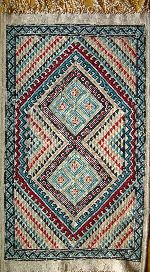
 The textiles that North Africa is best known for is
their knotted pile carpets (zerhivas), which the strongest evidence suggests
have their origins as decorative as well as functional pieces in the Middle
East.
The textiles that North Africa is best known for is
their knotted pile carpets (zerhivas), which the strongest evidence suggests
have their origins as decorative as well as functional pieces in the Middle
East.
 In contrast, the indigenous rural Berber women have a tradition of weaving short-nap, flat
weave rugs or tapestries; their products fall into two categories; mergum
or mergoum, which are woven and
In contrast, the indigenous rural Berber women have a tradition of weaving short-nap, flat
weave rugs or tapestries; their products fall into two categories; mergum
or mergoum, which are woven and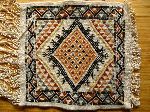 embroidered and kilim or klim which are only
woven. The “Mergoum” and “Klim” are characterized by the combination
of two simple geometrical
embroidered and kilim or klim which are only
woven. The “Mergoum” and “Klim” are characterized by the combination
of two simple geometrical
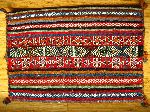 patterns, the lozenge (or diamond shape) and the
triangle. (All of the pieces shown here are from Tunisia.)
patterns, the lozenge (or diamond shape) and the
triangle. (All of the pieces shown here are from Tunisia.)
 Berber designs from the south
of Tunisia also incorporate animal figures -- most often camels. Contemporary
urban, mechanized weaving is more the domain of men.
Berber designs from the south
of Tunisia also incorporate animal figures -- most often camels. Contemporary
urban, mechanized weaving is more the domain of men.

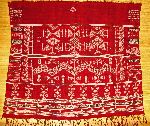 The ajar is a large Berber shoulder cloth woven
using natural black and white wool and typically
has horizontal bands decorated with supplementary-weft patterning. The
supplementary-weft patterning employs wool and white cotton to create the
design. The motifs are derived from traditional silver
jewelry, henna body painting and tattoos. After the shawl is woven it gets dyed
in red for newly wed bride and blue or black for older women. The wool absorbs
the dye while the cotton remains white and the result is white patterning
against darker ground. Other styles of Tunisian shawls are kitfeya
(smaller shoulder cloth), baknough (large, rectangular
'blankets'), and mushtia (large and long).
The ajar is a large Berber shoulder cloth woven
using natural black and white wool and typically
has horizontal bands decorated with supplementary-weft patterning. The
supplementary-weft patterning employs wool and white cotton to create the
design. The motifs are derived from traditional silver
jewelry, henna body painting and tattoos. After the shawl is woven it gets dyed
in red for newly wed bride and blue or black for older women. The wool absorbs
the dye while the cotton remains white and the result is white patterning
against darker ground. Other styles of Tunisian shawls are kitfeya
(smaller shoulder cloth), baknough (large, rectangular
'blankets'), and mushtia (large and long).
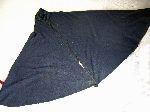 The
burnous or bounous are tightly woven, sleeveless, hooded,
woolen cape or cloak, often in brown or blue, worn in winter by men. They
dates back to the Roman era and were part of the traditional wardrobe of Berber
populations before the Arab conquest. They can be made with camel hair or
sheep wool and can take six months to make. Now a day they are being
increasingly supplanted by western outer wear. The lighter weight, hooded
and sleeved djebellas retain more popularity, perhaps because of the
boost they received for being the inspiration for the Jedi robes of the Star
Wars franchise. They are worn by both men and women, are available in
hundreds of colors and have gained the attention of designs so buyers can shop
for style as well.
The
burnous or bounous are tightly woven, sleeveless, hooded,
woolen cape or cloak, often in brown or blue, worn in winter by men. They
dates back to the Roman era and were part of the traditional wardrobe of Berber
populations before the Arab conquest. They can be made with camel hair or
sheep wool and can take six months to make. Now a day they are being
increasingly supplanted by western outer wear. The lighter weight, hooded
and sleeved djebellas retain more popularity, perhaps because of the
boost they received for being the inspiration for the Jedi robes of the Star
Wars franchise. They are worn by both men and women, are available in
hundreds of colors and have gained the attention of designs so buyers can shop
for style as well.
Click here for a virtual tour of Tunisia.
East Africa Woven Cotton Fabric (Ethiopia, Somalia, Kenya, Tanzania)
Gab i and
Netella are variations of Ethiopian
shawls. Gabi or gabby: is a heavy cloth which is best
describes as a throw or light blanket. Natella
(seen here)
is a light gauze like cloth, which usually has a very
colorful border on it, which is also found near the bottom hem of the women's
dress. Natella are considered trendy and are often used as an accent with
Western clothes such as jeans and other casual wear.
i and
Netella are variations of Ethiopian
shawls. Gabi or gabby: is a heavy cloth which is best
describes as a throw or light blanket. Natella
(seen here)
is a light gauze like cloth, which usually has a very
colorful border on it, which is also found near the bottom hem of the women's
dress. Natella are considered trendy and are often used as an accent with
Western clothes such as jeans and other casual wear.
Kikoi is a sarong-like piece of woven cotton, rectangular in shape, with multi-colored bands that tend to be near the edges. Traditionally kikois were a garment for men on the East African coast (Malindi, Mombasa, Tanga, Zanzibar, Dar es Salaam). They have now evolved into an item of clothing for all ages and sexes, and the cloth is used for all kinds of items like bags, pillows, pants, shorts, shirts, skirts, bikinis, robes, etc.
Shukas are the cloths worn by Masai men. They tend to prefer predominately red patterns, often plaid tartans.
Other East African Clothes (Uganda, Kenya)
Bark cloth was traditional in central Uganda for hundreds of years prior to contact with the Europeans. In commenting on the construction Speke wrote, "They were sewn together as well as any English glover could have pieced them." Clothes, especially for the royal family, were tailored from the inner bark a fig-tree (Ficus Natalensins), locally known as Mutuba. The bark is harvested during the rainy season and is a renewable resource. After bark is harvested, the tree is wrapped in banana leaves to help it heal. The bark grows back again in three months, thus it is possible to harvest the bark again and again. To prepare the bark it was been beaten with grooved mallets to produce the look of corduroy, the texture of silk and a terra cotta color.
Now a day bark cloth is used for small items like book/diary/journal covers, purses and hats, but it is rare to find large articles of clothing made from it. The cloth is worn mainly at coronation and healing ceremonies, funerals and cultural gatherings.
Gorfa is the sheepskin or goatskin worn by women of the northern Kenya's nomadic ethnic groups. It is dyed red or black and wrapped around the body and held in place with a leather cord or a rope belt.
Gudza Fabric (Zimbabwe)
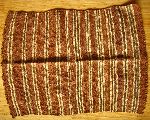 Gudza
fabric comes from Chimanimani area in the
Eastern Highlands of Zimbabwe. Gudza is twisted fiber from the inner tree
bark. Different sources list this as being Musasa/Munondo (Brachystegia /
Julbernardiaspp) tree or the baobab tree (Adansonia digitata). The bark fibers
are soaked to soften it before being woven. Traditionally it is chewed to
make them even suppler before
being dyed and woven.
Gudza
fabric comes from Chimanimani area in the
Eastern Highlands of Zimbabwe. Gudza is twisted fiber from the inner tree
bark. Different sources list this as being Musasa/Munondo (Brachystegia /
Julbernardiaspp) tree or the baobab tree (Adansonia digitata). The bark fibers
are soaked to soften it before being woven. Traditionally it is chewed to
make them even suppler before
being dyed and woven.
Kuba Cloth and Mashamba (Congo, Angola, Namibia, Botswana)
Mashamba is the Siyeyi name for a fabric which is similar to the better known Kuba cloth. The Yeyi people, who now live in the Kavango and Okavango districts of Namibia and Botswana, are believed to be originally from Congo or north-west Zambia. This would explain the similarity in material culture with the Kuba people of the Democratic Republic of Congo (formerly known as Zaire). The mashamba is worn by woman, tied around their waist, during traditional occasions. It sits on their buttocks and bounces up and down when they dance.
Kuba cloth is indigenous to the Kuba People. This textile is tightly woven using strands from raffia palm leaves for both warp and weft. Raffia strands are also interwoven between the warp and weft to create intricate geometric patterns. Kuba cloth comes in two styles. One has a rich and velvety pile; the other has a flat weave will little or no pile. To create Kuba cloth, vegetable dyes are used on raffia threads that are then embroidered onto finished cloth to create patterns such as rectangles, lines, creative curvatures, and circles that all have special meanings. Applique' is another technique used to create Kuba patterns. Panels and strips of Kuba are sewn together to make larger pieces of cloth (as in the above piece). Kuba cloth is used for ceremonial skirts, wall hangings, or mats for sitting and sleeping.
Baskets and Bags
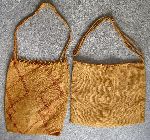
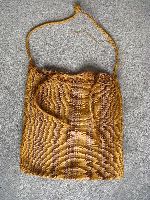 Also
part of the weaving tradition in Africa are baskets, bags, fishing nets, fish
traps and various other household items. These can be found from one time
of the continent to the other. The diversity is style, material and design
is a topic in itself. Baskets aren't as easy to carry on a bicycle (or
even airplane) so our collection is not as extensive but maybe during some
period of gray weather we will start to inventory and photo graph what we have.
For now here are a couple of raffia bags from Liberia that were stored with the
textile collection.
Also
part of the weaving tradition in Africa are baskets, bags, fishing nets, fish
traps and various other household items. These can be found from one time
of the continent to the other. The diversity is style, material and design
is a topic in itself. Baskets aren't as easy to carry on a bicycle (or
even airplane) so our collection is not as extensive but maybe during some
period of gray weather we will start to inventory and photo graph what we have.
For now here are a couple of raffia bags from Liberia that were stored with the
textile collection.
![]() Return
to Table of Contents of Textiles in Africa
Return
to Table of Contents of Textiles in Africa
More on Africa
Bibliography for Africa: Delve more into the literature, culture, history, philosophy and science of Africa.
General
Country-by
-Country Travel
Resources:
Algeria
Benin
Botswana
Burkina Faso
Cameroon
Cote d'Ivoire
Dem. Rep of Congo
Djibouti
Egypt
Eritrea
Ethiopia
Gambia
Ghana
Guinea
Kenya
Madagascar
Malawi
Mali
Mauritania
Morocco
Mozambique
Niger
Nigeria
Senegal
Sierra Leone
Sudan
Somalia
South Africa
Tanzania
Togo
Tunisia
Uganda
Zaire
Zambia
Zimbabwe
For current news on Africa and more web sites with country-by-country information go to the link section and click on "Africa: News, Background, Travel."
Home | About Us | Contact Us | Contributions | Economics | Education | Encouragement | Engineering | Environment | Bibliography | Essay Contest | Ibike Tours | Library | Links | Site Map | Search
![]()
The International Bicycle Fund is an independent, non-profit organization. Its primary purpose is to promote bicycle transportation. Most IBF projects and activities fall into one of four categories: planning and engineering, safety education, economic development assistance and promoting international understanding. IBF's objective is to create a sustainable, people-friendly environment by creating opportunities of the highest practicable quality for bicycle transportation. IBF is funded by private donation. Contributions are always welcome and are U.S. tax-deductible to the extent allowed by law.
![]()
![]() Please write if you have questions, comment, criticism, praise or
additional information for us, to report bad links, or if you would like to be
added to IBF's mailing list. (Also let us know how you found this site.)
Please write if you have questions, comment, criticism, praise or
additional information for us, to report bad links, or if you would like to be
added to IBF's mailing list. (Also let us know how you found this site.)




